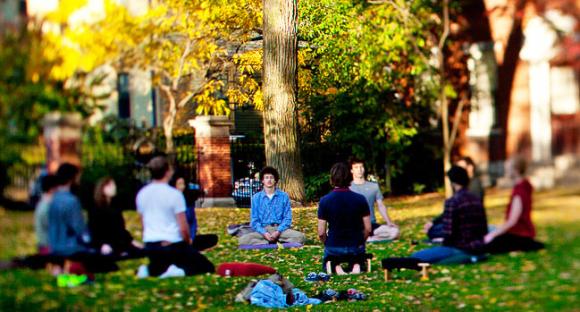What is contemplative studies?
Contemplative studies is a deeply interdisciplinary program that involves both scientific and humanistic approaches — and artistic approaches — to studying the human contemplative experience across cultures and time.

“We want to help students ... take contemplative practices out of classroom and into the world.”
We’ve developed an integrative contemplative pedagogy that combines a traditional third-person academic approach with what we call critical first-person engagement that allows students to actually try some of the contemplative practices that we teach. Students learn what the normative claims of each practice are but they have no commitment to whether or not those claims are true, so we test them out empirically. For example, in an early text from the oldest complete collection of the Buddhist canon, there’s a section on the mindfulness of breathing in and breathing out. We read that text and understand that text in its philosophical and historical context. That’s the third-person approach. Students then attend “Medlabs” in which they try out the very techniques they’re reading about in the texts and then come together to discuss them. It’s a wonderful pedagogical tool because they really understand the text much better if they actually have a direct experience and engagement with that text.
How does science come into the concentration curriculum?
Two of the five core courses for the concentration are introductory science courses. In a third, UNIV 0540: “An Introduction to Contemplative Studies,” we look at the scientific studies on the neurological and physiological changes that occur when people engage in these contemplative practices.
In addition, we work with two researchers at Brown who are doing some of these studies: Willoughby Britton, who runs the Clinical and Affective Neuroscience Lab, and Catherine Kerr, who runs the Translational Neuroscience Lab.
In one of her studies, Britton compares the effects of meditation on different sets of students: Medlab students — students who are taking a contemplative studies course that contains a critical first-person component — music students, and dance students. She found some really interesting things. All three reported an increase in the ability to focus and pay attention. But in only the courses that contained meditation labs was there a significant difference in the emotional lives of the students, including a decrease in anxiety and depression, decrease in self-judgment, and increase in self-compassion and compassion for others.
Why was now the time to turn the initiative into a concentration?
There are a number of reasons. We’ve reached a critical mass of core faculty that’s a good strong balance of scientists and humanists. We’ve also left open the possibility of the third track in the arts and we really want to support students who either do a dual concentration or independent concentration with contemplative studies and one of the arts, because it’s a natural fit. There’s a group at RISD that’s very interested and we have many faculty who are very supportive.
Additionally, I really do think that mindfulness and contemplative practices have become more acceptable in North American culture at this point in time. A major driving force has been the scientific research. There are now thousands of articles on the physiological, neurological, and cognitive effects and the clinical impacts of regular contemplative practices. There are also people in popular culture who have embraced contemplative practices and that helps to increase awareness.
Over 100 colleges and universities in North America teach some form of contemplative studies in the classroom but none of them has integrated a full-fledged undergraduate concentration. We’re the first. And none has developed this integrative contemplative pedagogy that we have.
What are the academic requirements of the concentration?
It’s fairly rigorous. There are five core courses: an introduction to contemplative studies, two introductory courses in the humanities and two in the sciences. We want to make sure that our humanists get basic science and our scientists get basic humanities, so they take courses in each before they choose either a humanities or science track. They do six depth courses in one track and a breadth course in the arts.
What can students do with a contemplative studies concentration?
As an initiative, we supported students in doing independent concentrations in contemplative studies. We’ve had 16 independent concentrators in some aspect of contemplative studies and probably close to 40 whom we have guided to contemplative studies focuses in other concentrations. We’ve had a fair share that have gone on to medical school, and reports from them are that the skills they learned helped them get into good medical schools and eventually good residency programs. We have one graduate who is studying to be a contemplative surgeon, and another studying for a neuroscience degree. Another graduate is pursuing his master’s in peace studies and there is one that went on to become a Tibetan Buddhist nun. Others have brought their knowledge of contemplative practices into schools and prison systems.
So there’s a variety of things. The potential influence of contemplative practices and ideas has resonance in many aspects of human life and can be a great benefit in society. We want to help students figure out ways to take contemplative practices out of classroom and into the world.

